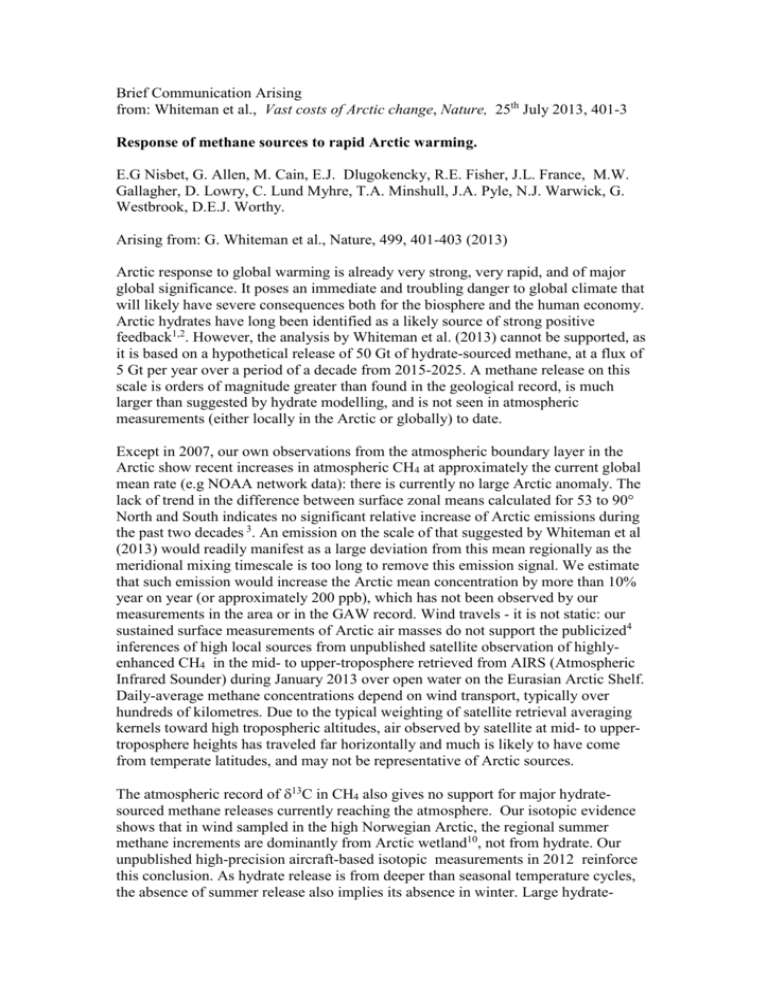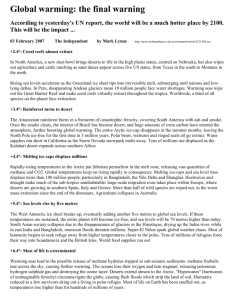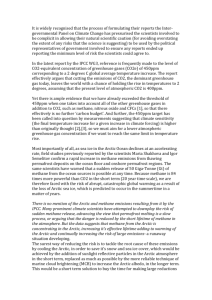Brief Communication Arising - Personal Webpages (The University
advertisement

Brief Communication Arising from: Whiteman et al., Vast costs of Arctic change, Nature, 25th July 2013, 401-3 Response of methane sources to rapid Arctic warming. E.G Nisbet, G. Allen, M. Cain, E.J. Dlugokencky, R.E. Fisher, J.L. France, M.W. Gallagher, D. Lowry, C. Lund Myhre, T.A. Minshull, J.A. Pyle, N.J. Warwick, G. Westbrook, D.E.J. Worthy. Arising from: G. Whiteman et al., Nature, 499, 401-403 (2013) Arctic response to global warming is already very strong, very rapid, and of major global significance. It poses an immediate and troubling danger to global climate that will likely have severe consequences both for the biosphere and the human economy. Arctic hydrates have long been identified as a likely source of strong positive feedback1,2. However, the analysis by Whiteman et al. (2013) cannot be supported, as it is based on a hypothetical release of 50 Gt of hydrate-sourced methane, at a flux of 5 Gt per year over a period of a decade from 2015-2025. A methane release on this scale is orders of magnitude greater than found in the geological record, is much larger than suggested by hydrate modelling, and is not seen in atmospheric measurements (either locally in the Arctic or globally) to date. Except in 2007, our own observations from the atmospheric boundary layer in the Arctic show recent increases in atmospheric CH4 at approximately the current global mean rate (e.g NOAA network data): there is currently no large Arctic anomaly. The lack of trend in the difference between surface zonal means calculated for 53 to 90° North and South indicates no significant relative increase of Arctic emissions during the past two decades 3. An emission on the scale of that suggested by Whiteman et al (2013) would readily manifest as a large deviation from this mean regionally as the meridional mixing timescale is too long to remove this emission signal. We estimate that such emission would increase the Arctic mean concentration by more than 10% year on year (or approximately 200 ppb), which has not been observed by our measurements in the area or in the GAW record. Wind travels - it is not static: our sustained surface measurements of Arctic air masses do not support the publicized4 inferences of high local sources from unpublished satellite observation of highlyenhanced CH4 in the mid- to upper-troposphere retrieved from AIRS (Atmospheric Infrared Sounder) during January 2013 over open water on the Eurasian Arctic Shelf. Daily-average methane concentrations depend on wind transport, typically over hundreds of kilometres. Due to the typical weighting of satellite retrieval averaging kernels toward high tropospheric altitudes, air observed by satellite at mid- to uppertroposphere heights has traveled far horizontally and much is likely to have come from temperate latitudes, and may not be representative of Arctic sources. The atmospheric record of 13C in CH4 also gives no support for major hydratesourced methane releases currently reaching the atmosphere. Our isotopic evidence shows that in wind sampled in the high Norwegian Arctic, the regional summer methane increments are dominantly from Arctic wetland10, not from hydrate. Our unpublished high-precision aircraft-based isotopic measurements in 2012 reinforce this conclusion. As hydrate release is from deeper than seasonal temperature cycles, the absence of summer release also implies its absence in winter. Large hydrate- sourced releases are indeed already occurring, such as submarine plumes we have observed offshore Spitsbergen 11, but most gas is taken up in the water column, and the methane flux reaching the air is currently limited. Hydrates are stabilized by pressure and low temperature. Thus they are near seabed under ~400 m of water, on land buried by hundreds of metres of sediment, or on the shallow Arctic shelf under ~40 m seawater and ~200 m relic permafrost and sediment. It takes time for a heat shock to penetrate so deep. On land, heat must travel downwards. Ocean water at 400m depths must respond to surface warmth. Shelf waters warm more rapidly, but heat must still penetrate underlying sediment. Released methane must then pass through the oxidation and dissolution zones to reach air. Although local bubbling may be intense, mathematical models of hydrate decomposition 1,2 and also the glacial termination record 6 suggest the bulk of hydrate degassing will be "chronic" 7, spread over centuries or millennia, rather than catastrophic, . There are roughly 5 Gt of methane in the modern global atmospheric burden, with a total global flux of about 0.5 Gt per year 3. Sudden Arctic warming, with very sharp temperature rises over a period of a few decades, has occurred in the past during glacial terminations 5, accompanied by increases in the global methane burden of about 1 Gt, supported by flux increases of very roughly 0.1 Gt. This was likely driven dominantly by wetland emissions 6, but probably also with releases from decaying methane hydrates 1,2,6. This would imply that in glacial terminations, despite the scale and speed of Arctic warming, the likely hydrate-sourced flux was probably less than 0.05 Gt annually 2. After millennia of cold, Late Glacial hydrates were probably more abundant and more rapidly destabilized by marine transgression and warming than will be the case in the current rapid Arctic warming; Whiteman et al.'s 100x greater modelled future flux from 2015-2025 is thus very improbable. Clearly large individual events can and probably will occur in the near future, such as major pockmark bursts and massive submarine landslides on hydrate 8,9, while local bubbling may be widespread on shelf seas. But even with such events the geological record shows that total decadal hydrate-sourced fluxes are very unlikely to exceed 1 Gt, and may be far less than that. A 50 Gt decadal release is thus not credible. Arctic methane emission is certainly a major and potentially dangerous climate feedback, of global significance. It is likely both from sharply more productive wetlands and from marine and terrestrial hydrates. This is an important and potentially powerful consequence and reinforcer of global warming. Arctic methane emission needs to be closely studied and carefully monitored. However, while hydrates are indeed important, they need to be held in context. In the natural system, globally, the response of wetlands (including tropical wetlands) demands careful monitoring. Large but reducible anthropogenic methane emissions, such as gas and coal-sourced leaks, and deliberate biomass fires, need attention. The climate debate is complex and best served by studies that are factually based, rooted on ongoing observation. 1. Nisbet, E. G. (1989), Some northern sources of atmospheric methane - production, history and future implications, Can. J. Earth Sci., 26(8), 1603-1611. 2. Nisbet, E.G. (1990) The end of the ice age. Can. J. Earth Sci., 27, 148-157. 3. Dlugokencky, E.J., Nisbet, E.G., Fisher, R.E., and Lowry, D. (2011) Global atmospheric methane in 2010: Budget, changes and dangers. Phil. Trans, R. Soc. Lond. A. 369, 2058–2072 4. Arctic News Blog. http://arctic-news.blogspot.com/2013/02/dramatic-increase-inmethane-in-the-arctic-in-january-2013.html 5. Severinghaus, J. P. & Brook, E. J. 1999 Abrupt climate change at the end of the last glacial period inferred from trapped air in polar ice. Science 286, 930-934. 6. Nisbet, E.G. and Chappellaz, J., (2009) Shifting gear, quickly. Science 324, 477-8. 7. Archer, D, Buffett, B., and Brovkin, V., (2008) Ocean methane hydrates as a slow tipping point in the global carbon cycle, Proc. Natl. Acad. Sci. 106, 20596–20601 8. Krey, V., Canadell, J.G., Nakicenovic, N., Abe, Y., Andruleit, H., Archer, D., Grubler, A., Hamilton, N.T.M., Johnson, A., Kostov, V., Lamarque, J-F. Langhorne, N., Nisbet, E.G., O’Neill, B., Riahi, K., Riedel, M., Wang, W., and Yakushev, V. (2009) Gas Hydrates: Entrance to a Methane Age or Climate Threat? Environmental Research letters.034007. 9. Thorpe, R.B., Law, K.S., Bekki, S., Pyle, J.A., & Nisbet, E.G. (1996) "Is methanedriven deglaciation consistent with the ice core record?",Journal of Geophysical Research, 101, 28627-28636 10. Fisher, R.E., Sriskantharajah, S., Lowry, D., Lanoisellé, M., Fowler, C.M.R., James, R.H., Hermansen, O., Lund Myhre, C., Stohl, A., Greinert, J., Nisbet, P.B.R., and Nisbet, E.G., (2011) Arctic methane sources: isotopic evidence for atmospheric inputs. Geophysical Research Letters, 38, L21803. doi:10.1029/2011GL049319 11. Westbrook, G., Thatcher, K., Rohling, E.J., Piotrowski, A.M., Palike, H., Osborne, A.H., Nisbet, E.G., Minshull, T.A., Lanoisellé, M., James, R.H., Huhnerbach, V., Green, D., Fisher, R.E., Crocker, A.J., Chabert, A., Bolton, C., Beszcynska-Moller, A., Berndt, C., and Aquilina, A. (2009) Escape of methane gas from the seabed along the West Spitsbergen continental margin. Geophys. Res. Lett. 36, L15608 Nisbet, E.G. (1992) Sources of atmospheric CH4 in early postglacial times. Journal of Geophysical Research, 97, 12859-67. Nisbet, E. G., and B. Ingham (1995), Methane output from natural and quasi-natural sources: a review of the potential for change and for biotic and abiotic feedbacks, in Biotic feedbacks in the global climate system: Will the warming feed the warming?, edited by G. M. Woodwell and F. T. Mackenzie, pp. 188-218, Oxford University Press, Oxford.






